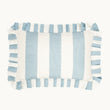How to wash silk
Silk is an opulent and delicate fabric that needs to be treated with care. Taking your silk bedding or clothing to a professional cleaning service is a great way to ensure your items will be treated correctly, especially if you have noticed any stains that may be difficult for you to remove at home. However, for general care and cleaning purposes, you can clean silk at home and it is not as difficult as you may think, with just a few simple steps to remember.
Can you wash silk in a washing machine?
You can wash your silk in a washing machine, which is excellent news for those living a busy and active lifestyle and do not have the time to wash silk by hand. We would recommend placing your silk items in the washing machine without any other types of fabrics, this will help to ensure your silk gets a thorough cleaning and reduces the risk of colour transfer or any rough materials tarnishing your delicate silk. When it comes to starting the cycle, there are a few additional steps you should follow to make sure your silk comes out the machine as luxuriously soft as it went in:
2) Use a specialist silk washing detergent such as the Gingerlily Liquid Silk Wash. We do not recommend the use of household detergents, fabric softeners, scent boosters, and laundry disinfectants. The chemicals in these products can be quite harsh on such a delicate fabric, and can ruin the quality of your silk. Silk is naturally soft and antibacterial, so these extra products are not needed.
3) If you have a delicates laundry washing bag (preferably made of silk itself to reduce friction against harsh materials), we’d recommend placing your silks inside and securing the fastening as this will provide an extra layer of protection.
4) Line dry or air dry your silk after the washing cycle is completed, but avoid hanging the silk in direct sunlight as this can cause fading.

Gingerlily Liquid Silk Wash - £15.00

For item-specific guides to help you gain a more thorough understanding of caring for your silk, take a look at our Gingerlily Journal. This includes useful articles such as ‘how to clean a silk sleep mask’ and ‘how to wash a silk pillowcase’.
How to handwash silk
If you wish to wash your silk by hand instead of using the washing machine, simply fill a clean sink, bucket, or tub with lukewarm water, making sure that the temperature does not go above 30 degrees. You can use a small amount of silk wash and lightly agitate or soak for 3-5 minutes, do not scrub the material. It is not recommended that you leave silk to soak any longer than 5 minutes.
The next step is to rinse the item, you can do this by emptying the basin and replenishing the water and gently rinsing, repeating the process one more time to ensure all of the detergent has been rinsed away. You could also rinse the product under a gentle stream of cold water from the tap.
Finally, when it comes to drying, it is advisable that you lay the product on top of a towel and roll it up, gently pressing to remove excess water. Do not twist or wring your silk as this can cause damage or distortion to the product. Once the excess water has been absorbed, you can lay the product on a fresh dry towel or leave it to air dry out of direct sunlight.
How to remove stains from silk
If your silk has a stain, it is usually best to take it to a professional cleaning service that knows how to deal with this type of fabric. If you are going to try to treat it yourself, never use any harsh stain removing agents or bleach.
Treat the stain by applying silk detergent to the area and letting it sit for a few minutes before washing. This is best done as soon as possible after the stain occurs. If the stain is tough, try using 1 part white vinegar to 1 part lukewarm water.
Do not use soap as this can damage the fabric, and requires more dabbing to remove the suds, which can result in the fabric fraying or degrading over time as silk is more fragile when wet.
Can you place silk in a tumble dryer?
You should never place your silk in a tumble dryer. Drying at high temperatures will cause shrinking, and irreversible damage to such a natural fabric. The best way to dry silk is to flat dry, out of direct sunlight, as this will help to keep the shape and colour intact. You can also line dry your silk items, but you should be aware that prolonged drying like this may sometimes stretch the fibres.
Similarly to drying, you shouldn’t iron your silk at high temperatures to remove creases. If your iron has a silk setting, make sure to use it. Otherwise, you will need it on a low temperature and to iron your silk inside out when it is still slightly damp to restore its natural sheen.
How to wash silk filled pillows, duvets, and mattress toppers
Whilst silk clothing, bedding, and pillowcases can be washed as outlined above. Silk-filled items are a little bit different. Most domestic drums aren’t suited for cleaning silk filled duvets, pillows, and mattress toppers, and if you are using protectors and removable covers, these items will almost never need to be washed as silk is naturally hypoallergenic and antimicrobial.
If you must clean these items, it is highly recommended to take them to a professional, along with any throws and bedspreads. The majority of these items should be spot cleaned only, which will be a simple job for an experienced professional to get your silk filled items looking and feeling pristine, restoring their unmatched softness and luxurious nature.
Protect your silk with Gingerlily
At Gingerlily, we know how important it is to keep your silk looking its best, from the washing process to the storing process. That’s why we offer a range of products designed to help keep your silk protected, from our liquid silk wash to our silk laundry bags that keep your items fresh whilst stored away.
If you’d like to learn more about the benefits of silk, keep an eye on our Gingerlily Journal which features detailed information about this luxurious natural material.
Collapsible content

UK
Harrods
87-135 Brompton Road,
Knightsbridge,
London,
SW1X 7XL
Cologne & Cotton
39 Kensington Church Street
London
W8 4LL
Sarah Chapman
259 Pavilion Rd
London
SW1X 0BP
The French Bedroom Company
Woods of Harrogate
65/69 Station Parade
Harrogate
HG1 1ST
Barretts of Woodbridge
40-42 Thoroughfare
Woodbridge
Suffolk
IP12 1AL
Cologne & Cotton
88 Marylebone High Street
London
W1U 4QX
Cologne & Cotton
74 Regent Street
Leamington Spa
Warwickshire
CV32 4NS
Fiona Finds
29 Lowndes Street
LONDON
SW1X 9HX
Sweetpea & Willow
Unit 15, The Metro Centre
St John's Road
Isleworth
TW7 6NJ
Seymour's Home
24 Grange Road
Darlington
DL1 5NG

Europe

USA
Bloomingdales
59th St and 1000 3rd Avenue,
New York, NY, 10022
Bloomingdales
900 North Michigan Avenue,
Chicago, IL 60611
Fine Linens
1193 Lexington Ave,
New York, NY 10028
Smithsonian Museum
600 Independence Ave SW,
Washington, DC 20004
Demeter Home
2980 E Church St,
Pine Plains, NY 12567
Bloomingdales
The Mall at Short Hills,
1200 Morris Turnpike,
Short Hills, NJ 07078
Bloomingdales
10250 Santa Monica Blvd,
Los Angeles, CA 90067
Leron Inc.
140 Elm Street,
New Canaan, CT 06840
Arturo Group
42 Midoaks St,
Monroe, NY 10950


